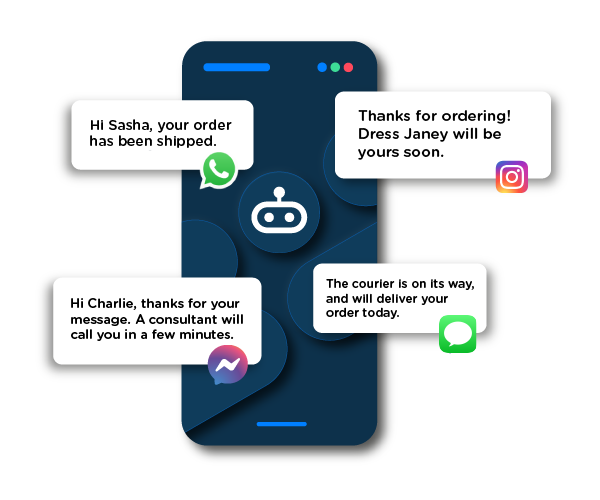- 1. Content Marketing
- 2. Chatbots
- 3. Email Marketing
- 4. Webinars
- Riding the Digital Wave
The financial services industry has evolved; people can now conduct certain transactions entirely via online channels from a device that fits within their hand. And many of them do: in a study conducted by digital security platform Entrust, for example, 65% of Singapore respondents shared that they most often did their banking using their bank’s mobile or tablet app.
As financial services go digital, so must your marketing efforts. Otherwise, you’re missing many opportunities to promote your offerings and provide the personalized service that customers want.
Read on as we share four digital marketing trends that financial service businesses should leverage to facilitate an omnichannel presence and boost customer adoption.

1. Content Marketing
Content marketing is creating and distributing content to attract and nurture readers into customers.
The content medium can range from blog posts to videos, podcasts, case studies, and more. What’s critical, however, is that your target audience should find your content valuable. Users who consume your content should go: “Wow, this was so helpful! I will keep an eye on more posts/videos/episodes from them.”
Apart from posting your content on your channels, you can also promote it on social media to reach out to users unfamiliar with your brand—and potentially expand your customer base.
When done consistently, content marketing offers opportunities to:
position your brand as an expert in the field to boost user trust and confidence,
educate users on your products and how they can address the user’s needs, and
keep your brand top of mind so that users will think of you as they search for solutions (and ideally buy your products afterward!)
Digital wealth management platform StashAway has thoroughly covered its content marketing bases. It maintains a blog called Insights, which publishes investing tips and marketing opinions. The platform also provides free StashAway Academy courses for users who want a more structured approach to learning investing skills and strategies.
Finally, StashAway invites financial leaders and bloggers to share their investment insights and experiences on a podcast titled In Your Best Interest to cater to auditory learners.
2. Chatbots
Chatbots are computer programs designed to converse with users and address their needs. Their features typically involve answering questions and assisting with simple customer service issues. (If the matter is trickier, a human support rep will take over.)

Integrating chatbots into your customer support processes opens opportunities for you to:
help customers get answers quicker as chatbots can operate round-the-clock,
improve the customer experience by providing personalized chat interactions,
free up your support representatives to focus on more complex customer support issues, thus cutting your operational and customer support costs, and
serve customers on their preferred channels. For instance, our Mobile Service Cloud omnichannel scripted chatbot solution lets you set up a support presence on your website, plus popular chat apps such as WhatsApp and Instagram, and
promote your latest products, services, and offers across multiple channels.
DBS Bank’s chatbot offers a comprehensive menu of customer services, such as:
retrieving transaction details,
assisting with card replacement requests,
answering frequently asked questions, and
sharing ongoing deals and promotions.
For security reasons, users must first authenticate their login to DBS’s online banking services. After doing so, they can launch the chatbot and select the appropriate self-service menu option to get immediate assistance.
If the user does need human support, however, they can select the “Contact Me” option to leave a message for a representative’s follow-up action.
3. Email Marketing
Email marketing is a form of marketing that uses email to engage in targeted communications with segments of users. Emails have been around for a long time now, but still bring about marketing opportunities such as:
direct communication with users to build trust and authority without finicky and ever-changing algorithms affecting your campaigns’ reach (social media algos, we’re talking about you here), and
unifying your customer data through the use of powerful email marketing solutions. For example, CM.com’s Mobile Marketing Cloud lets you build comprehensive customer profiles from data obtained via various platforms, then personalize your email campaigns for higher engagement and lower unsubscribe rates.
Wise’s marketing strategy uses triggered email campaigns on their target market that promote its currency conversion service exceptionally well.
The money transfer platform lets users sign up for exchange rate email alerts that will notify them when a specific currency reaches its target exchange rate. For example, a user might want to receive an email alert when 1 USD hits the SGD 1.44 mark.
When this threshold is reached, Wise’s email marketing system is automatically triggered to send the user an email alert.
Wise’s rate alerts also include a link to its currency conversion services—because when a user learns that the mid-market rate has reached their desired rate threshold, the natural next step is to use Wise to convert their funds!
We also like how Wise’s email marketing strategy involves users setting up the alerts on the platform’s website themselves. This approach helps Wise precisely learn its users’ preferences, so it doesn’t send them irrelevant emails.
4. Webinars
Have you been to a seminar in a physical venue? The webinar is the online equivalent, where businesses hold seminars using a virtual conferencing platform such as Zoom.
Webinars exploded in popularity when organizing large gatherings became unfeasible due to the COVID-19 pandemic. But even in the current endemic conditions, webinars appear here to stay due to opportunities for businesses to:
position their brand as an authority by sharing knowledge with attendees or hosting experts in their fields to do the same,
increase their brand awareness as users can join webinars from any location and device. This allows businesses to scale their attendance numbers with a marginal increase in cost, and
produce more content for marketing purposes because it’s easy to record webinars for splitting into bite-sized video segments later.
Look no further than TD Ameritrade for an example of a well-oiled webinar strategy. The stock brokerage holds regular webinars on investment-related topics (sometimes even multiple sessions a day!)
TD Ameritrade’s webinars are categorized into beginner, intermediate, and advanced topics to help users decide which webinar is right for them based on their level of investment experience. To increase the longevity of its webinar content, TD Ameritrade also records all its webinars and makes them available for viewing on demand.
Riding the Digital Wave
What’s the future of financial services? It’s reaching out to customers using digital marketing channels and helping to serve their needs via the online medium. At the same time, financial service businesses must consider using such technologies to provide a personalized customer experience.
“As consumers’ uptake of digital channels increases, their expectations of customer experience are also rising,” writes global management consulting firm, McKinsey. “Digital technologies raise the bar in that respect because they are enabling easy-to-use and personalized services.”

Despite the digital shift, physical services won’t become entirely obsolete. Due to security concerns, unfamiliarity with technology, or other reasons, some customers will still prefer completing transactions in person.
Businesses in the financial services industry will hence need to create an omnichannel presence on both the physical and digital fronts, from which they can:
market to customers,
offer a seamless customer experience, and
glean insights on customer behavior to guide their business strategy.
In the digital realm, CM.com’s Mobile Marketing Cloud provides an omnichannel customer engagement solution for financial service businesses to automate the delivery of tailored marketing campaigns on a wide range of digital channels.
Explore Mobile Marketing Cloud here to learn how it can digitally transform your marketing tactics and deliver the personalized experience that your customers seek.
